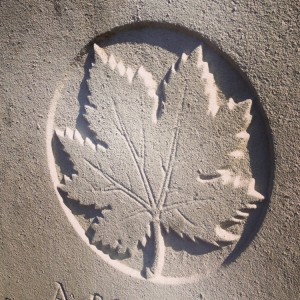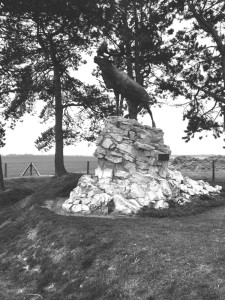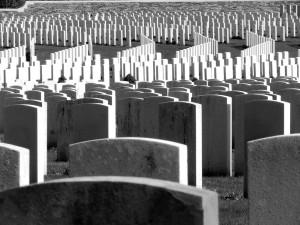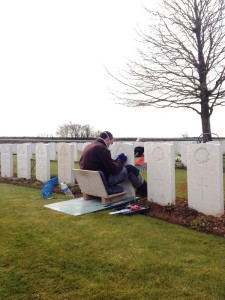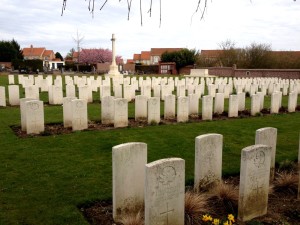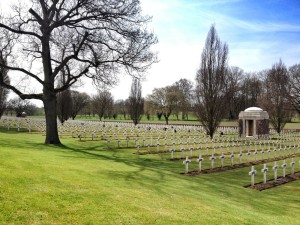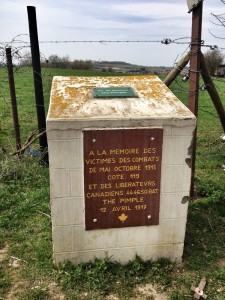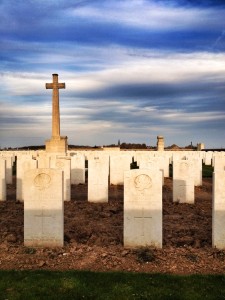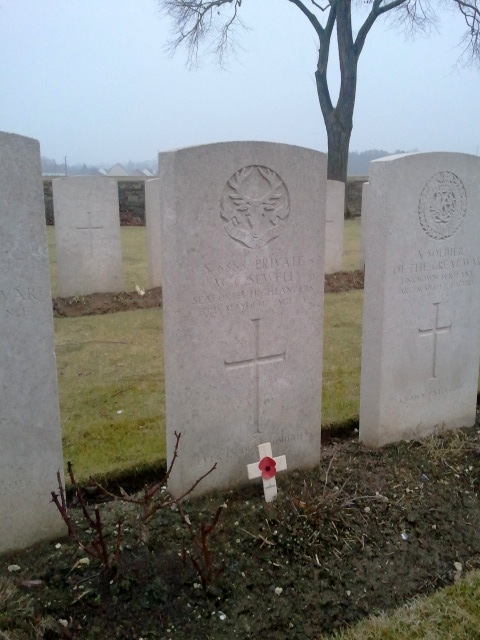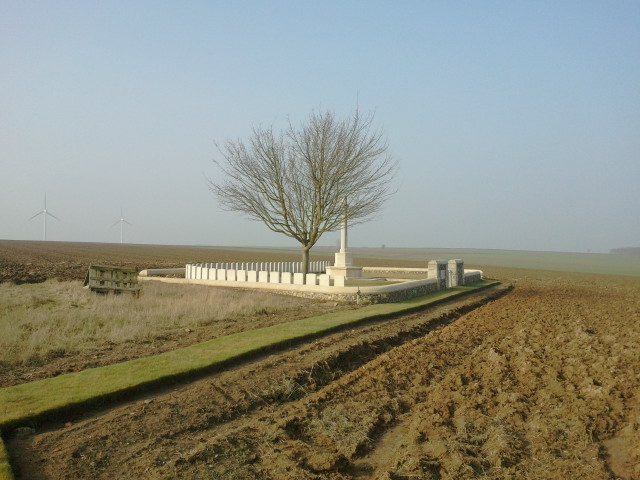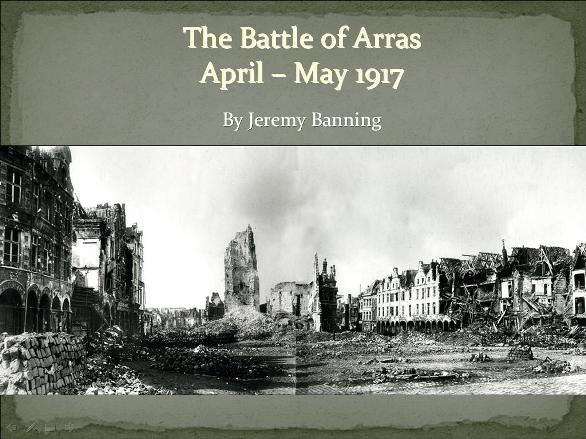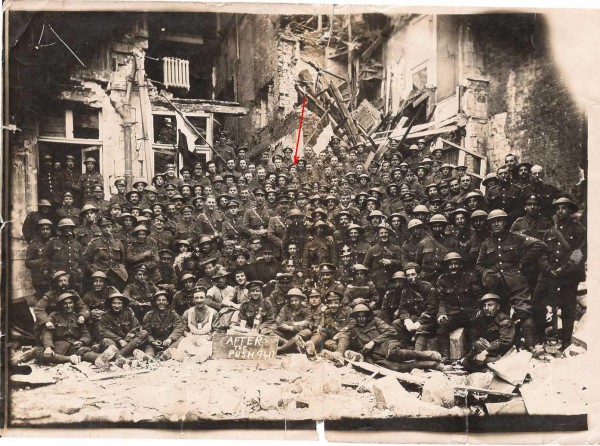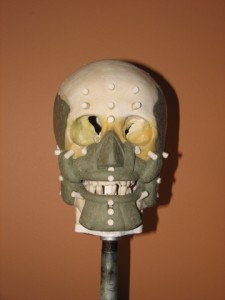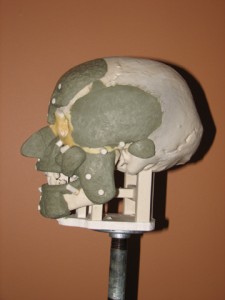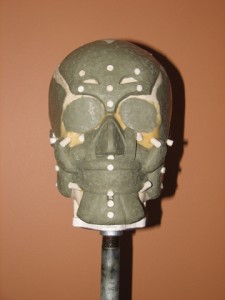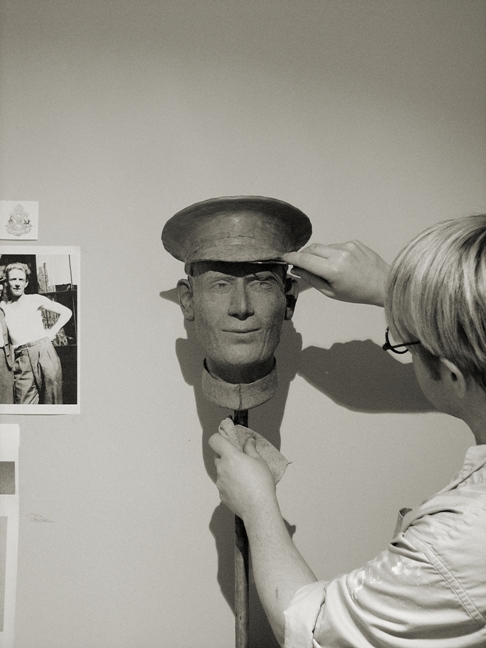Posts Tagged ‘Vimy’
From 2 – 4 March I was guiding a private battlefield tour. Late last year I had been asked to compile a report on S/8888 Private William Charles Sewell who served in the 2nd Battalion Seaforth Highlanders. William Sewell went overseas in November 1915, served through the Somme in 1916 and was killed at Roeux during the Battle of Arras on 3 May 1917. As well as compiling a detailed report on William Sewell’s war service I was asked to take his great nephew, Paul Carter with his friends to follow in William’s footsteps from Arras down to the Somme.
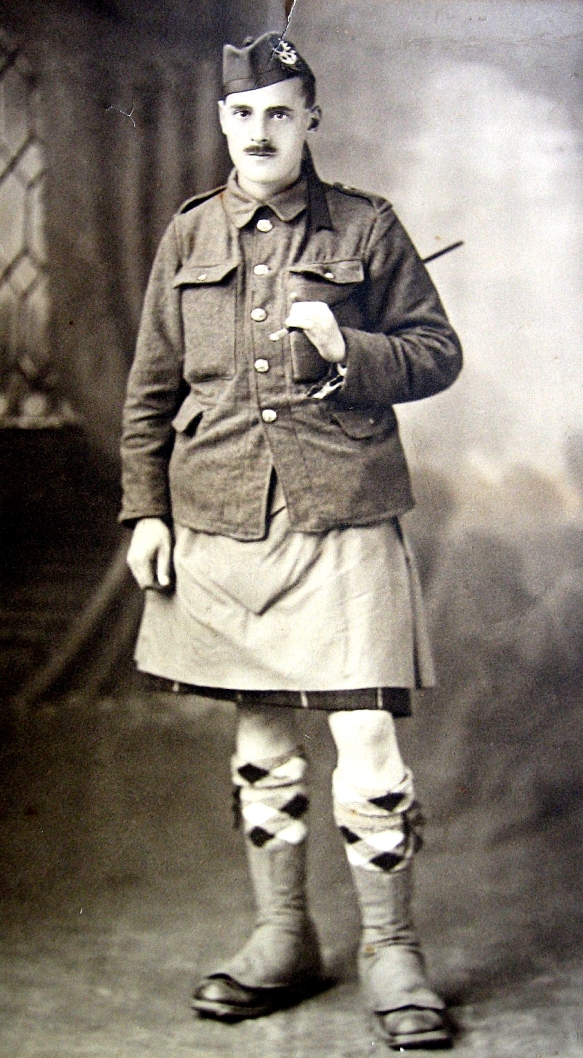
Private William Charles Sewell, 2nd Battalion Seaforth Highlanders. Killed 3 May 1917 during an attack at Roeux during the Battle of Arras. Many thanks to Paul Carter for his permission to use this photo.
Despite a distinct lack of decent weather for the entire trip we had a wonderful time and it was a real honour to be guiding the first member of William Sewell’s family to ever visit his grave. Starting at Vimy Ridge and the Memorial Park we began our tour of the Arras battlefields. After a stop at La Targette for the enormous French and German cemeteries we picked up the Athies road, following in the footsteps of the triumphant 9th (Scottish) Division in their advance on 9 April 1917. After a quick stop at Point du Jour Cemetery and the 9th (Scottish) Division memorial we headed to Fampoux, tracing the route of the 4th Division as they leapfrogged the Scots that day. Stopping at the Seaforths Cross at the Sunken Lane I explained the disastrous attack on 11 April 1917 and read an account of the operation from Private James Stout, a survivor of the attack. As one of those actions that holds a particular fascination for me it was all the more poignant being there with a relative of a soldier who may well have taken place in that ill-planned venture. The following account provides a bleak picture of subsequent events:
At ZERO Hour (12 noon) 2nd Seaforths and 1st Royal Irish Fusiliers advanced, the former on a 3 company front, the latter on a 2 company front. The 2nd Seaforth Highlanders’ objective was the cross roads I.13.a.9.3, exclusive to cross roads I.7.a.4.3 exclusive. Immediately these two battalions advanced, they came under a very heavy machine gun fire from the INN, CHEMICAL WORKS, STATION, CHATEAU and Railway Embankment. The whole ground in Squares H.12 and 18 appeared to be swept by machine gun fire.
At the same time a barrage was put down on FAMPOUX and East of the SUNKEN Road where the remaining two battalions were assembling. This machine gun fire very soon thinned the advancing lines but the troops continued to advance.
On the left, part of a company of the 2nd Seaforth Highlanders entered a new trench some 150 to 200 yards west of the 1st objective, about I.7.c.5.9.
This party under an officer [Lt Donald Mackintosh] maintained itself in the trench for some time, until its ammunition was exhausted, when they were forced back by a counter attack and only a few returned. The remainder, including the officer who is missing, were either killed or wounded, and left in this trench.
The heavy machine gun fire maintained by the enemy made it impossible to obtain information regarding the course of the action but it required no report that a single wave of 400 men who had to advance an average distance of 400 yards with a Battalion front of 1100 yards could not obtain their objectives in face of such machine gun fire and rifle fire.
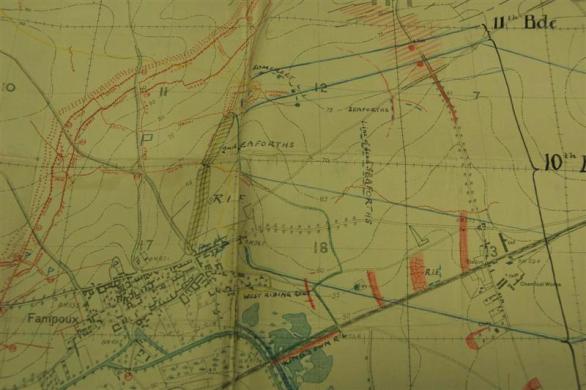
Map extract from 10th Brigade war diary showing 'line of dead Seaforths'. Ref: WO95/1479 10th Infantry Brigade War Diary. Copyright National Archives & reproduced with their permission.
After the debacle of 11 April 4th Division went back for some rest. Their next large-scale attack was the fighting at Roeux on 3 May. It was during this fighting that William Swell was killed. Starting next to the A1 motorway at Crump Trench Cemetery we followed the battalion through their part in the battle. The following map shows the objectives, named respectively the BLACK, BLUE and RED Lines. The total advance was so far as the 4th Division was concerned was to cover a distance of 2500 yards, including:
- The capture of the Northern portion of the village of ROEUX, including the CHEMICAL WORKS and STATION buildings.
- The capture of the trench system on the high ground near HAUSA and DELBAR Woods, and finally
- The piercing of the defences round PLOUVAIN, which were partially wired.
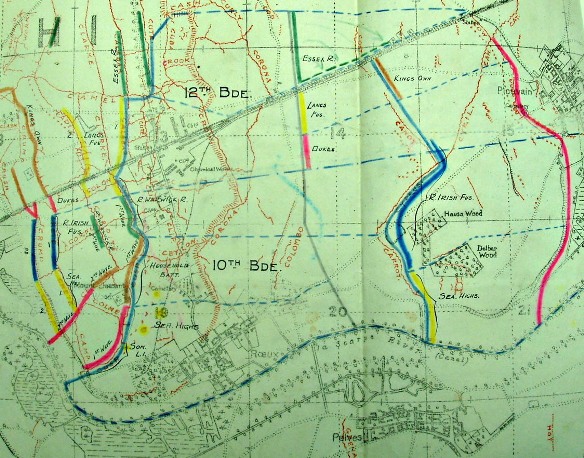
3 May 1917: the 4th Division's attack plan for Roeux . Positions for the 2nd Seaforths can be seen marked in yellow. Ref: WO95/1446 4th Division War Diary. Copyright National Archives & reproduced with their permission.
Of the attack, the war diary notes:
3 May – Zero hour 3.45am when a heavy bombardment of enemy’s position started, lasting for half an hour. Barrage then crept forward very slowly. Battalion left their trenches at 4.30am, being in support to the Household Battalion who were to capture the cemetery north of ROEUX. The Royal Warwickshire Regiment were on the left of the Household Battalion and Royal Irish Fusiliers on left of Seaforths, support to Royal Warwickshire Regiment. 1st Somerset Light Infantry were on the right and were to capture village of ROEUX. On reaching BLUE Line which was just west of DELBAR WOOD the Battalion moved to their right until left of each wave was opposite NW corner of DELBAR WOOD where a halt was made until ZERO + 85 = 5.10am when they advanced to capture the RED line, east of DELBAR and HAUSA WOOD, and immediately west of PLOUVAIN, through I.21.b. and I.15.d & b. This attack unfortunately failed owing to both flanks being held up and severe losses, and later on the whole Brigade line was forced to withdraw to original front line. The Battalion came back to CRETE Trench. This was the position until dark when the Battalion was sent to relieve the Household Battalion in CEYLON Trench from its junction with CORONA Trench I.19.a.8.7. to its junction with COX Trench I.19.a. 7.3. Company Sergeant Major Fraser was in charge of the line as all officers taking part in these operations had become casualties. The Commanding Officer, Adjutant, Medical Officer and three other officers became casualties of the same shell.
Delbar and Hausa Wood no longer exist. Le Lac Bleu (Blue Lake) now covers the ground on which the woods sat. Unless there is specific personal testimony it is notoriously hard to pinpoint the exact spot that a soldier was killed. However, as most casualties were sustained between the BLUE and RED lines it seems likely that William Sewell was killed in this area. Having followed the route of advance we returned to the ground between Fampoux and Roeux to pay our respects at William Sewell’s grave.
Crossing the Scarpe we drove up in Monchy-le-Preux and up Infantry Hill where I recounted the story of 14 April attack by the 1st Essex and Newfoundlanders and the resulting action of the small band of men who saved Monchy from German recapture. For our last stop of the day we headed to the Arras Memorial to Missing.
Next morning began with a windswept walk on the Hindenburg Line to the quiet delight of Rookery Cemetery and Cuckoo Passage Cemetery, the latter full of men of the Manchester Regiment killed on 23 April 1917.
We then headed back into Arras for a good tour of the underground boves and tunnels at Wellington Quarry. Our brief visit to Arras was now at an end as we headed south down to the Somme battlefields.
Our first stop was the Sheffield Memorial Park and the Gospel Copses at Serre (the 2nd Seaforths held the frontline trenches here in November – December 1915). We then headed to Redan Ridge to look at the part played by the 2nd Seaforths in the opening day of the Battle of the Somme, 1 July 1916. The operation plan was for 11th Brigade to take Munich Trench and then for 10th and 12th Brigades to pass through them at a given time and gain the final objective along the Beaucourt Ridge (2nd Seaforths were part of 10th Infantry Brigade)
The war diary offers the following explanation of events:
Zero at 7.30am. From 5.30am the very intense bombardment concentrated on the German trenches in front. At 7.30am the 11th Brigade moved forward from our front in waves.
By 8.45am no messages had come through from 11th Brigade. Patrols advanced and were met by heavy machine gun fire. Telephone to Brigade HQ was out so two orderlies were sent for orders. As they had not arrived by 9am – the hour appointed for the Battalion advance – the remainder of the Battalion moved forward.
On coming into view of the German trenches the Battalion came under heavy machine gun fire from the front and direction of Beaumont Hamel. After passing the German front, parties pushed forward and reached the third line of trenches. Other parties of our men may have reached Munich Trench but there was no possible communication and none returned.
By this time 11th Brigade had already lost their Brigadier, General Prowse (died of wounds) and all four Commanding Officers (killed). Enemy held first, second and third lines on our left and right. Attempts were made to consolidate the ground gained. Enemy bombed on flanks and the third line was given up at about 1pm.
By 11am there were only 5 officers left with the battalion and casualties were proportionately heavy in the ranks. During the evacuation of the third trench Drummer Ritchie sounded the Charge with the idea of encouraging these waverers who had lost their leaders. This gallant action in addition to his conduct throughout the day gained him the Victoria Cross.
We finally withdrew at about 5pm to original front line positions south of the Quadilateral. At this time there were about 40 men of the battalion left.
The war diary records the following casualties:
| Officers | Other Ranks | |
| Killed | 12 | 59 |
| Died of wounds | 1 | 6 |
| Wounded | 8 | 260 |
| Missing, believed killed | 0 | 1 |
| Missing | 0 | 53 |
| TOTAL | 21 | 379 |
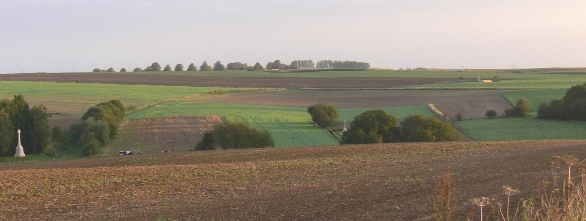
Redan Ridge viewed from a position on the Hawthorn Ridge. The German-held village of Beaumont Hamel is to the right of frame.
Further stops that afternoon included the Sunken Lane at Beaumont Hamel, scene of the infamous attack by 1st Lancashire Fusiliers on 1 July, Newfoundland Memorial Park with its preserved trenches and the Ulster Tower and Thiepval Memorial to the Missing. We finished by following the front line by Authuille Wood to Ovillers, down Mash Valley and then to the hotel at Albert.
Our final day dawned in thick fog which made pointing out sites rather difficult. Beginning with a stop at Fricourt and the Bois Francais we followed the British front line and saw the site of Siegfried Sassoon’s Military Cross action before heading to the site of the Livens Flame Projector site at Mametz. Dropping down to Devonshire Cemetery we headed toward Maricourt and the junction with the French Army on 1 July. Passing Trônes Wood, Guillemont and Ginchy we headed to the desolate fields between Lesboeufs and Le Transloy for our last in-depth look at the part played by the 2nd Seaforths during the Somme battle. Fighting in desperate mud with a thick mist (not unlike the weather on the day we visited) the battalion took place in two attacks in mid-October against German positions in Dewdrop and Rainy Trench. The Battalion war diary recorded the ground conditions in the area:
From Montauban eastwards the whole country is one stretch of absolute desolation – a more gloomy sight I have never seen. The ground is just a maze of shell holes, varying from size of stokes mortar crater to the size of a crater made by a 15-inch.
The attacks on the 14th and 23rd were pressed with utmost gallantry but typical resolute defence from German troops allied to the dreadful ground conditions encountered made any serious advance impossible.
After a walk around Delville Wood and a stop at Flat Iron Copse Cemetery and the Welsh Dragon Memorial at Mametz Wood we ended up at the Glory Hole at La Boisselle where I was able to show them around site and take them underground in W Adit. It had been a real pleasure spending time with these gentlemen. Thanks to Paul Carter and his friends Tim Halliday, Al Kendall and Richard Johnson for making me so welcome. I hope that we can do it again sometime soon – perhaps Ypres next time?
Thank you very much for the wonderful report on my Great Uncle William Sewell and the tailor made trip following in his footsteps 97 years later. Your local knowledge, historical expertise and professional service gave my small group a fantastic tour- better than we could have hoped for. The stories of individual’s personal experiences brought an extra dimension to the trip and brought to life briefly a few of the thousands of names inscribed on memorial walls or grave stones. We all agreed that trip would have been so much less of an event if we had tried to find our own way around, and we would have missed so many significant points. The battlefield overlays and WW1 panoramas were fantastic to relate to as we stood in the centre of all those events and you recounted the events played out. On our journey back there was plenty of talk about the next trip – until then! Paul Carter
I know all four of us found the experience fascinating, thought provoking, educational and frequently moving as well. Your own passion and knowledge of a crucial era in our history was captivating and I am sure like me, the other guys have been singing your praises to those they have talked to about the trip. It certainly was a weekend to remember. Al Kendall
Last Wednesday (19 October) I spoke at my local branch of the Western Front Association. The subject was one dear to my heart – “The Battle of Arras: April-May 1917”. It was the same talk that I gave to the Berkshire branch of the WFA back in April – see this BLOG article. This time I was allowed a bit longer and so spoke for 45 minutes which took us through the reasons for battle, political intrigues, German retreat to the Hindenburg Line, preparations, work of the RE and artillery and then a detailed look, division by division, working down the line on 9 April 1917 – the first day of battle. After a pleasant ten minute break I continued for a further half hour with details of the fighting for Monchy-le-Preux, Infantry Hill, Roeux and the Chemical Works and Gavrelle before culminating in a description of the disastrous 3 May attack – an attack on a 21km frontage in which 5,900 men were killed in a single day.
It was lovely to speak on ‘home’ turf; the branch in Kingswood being a mere ten minute drive from my house. I do my utmost to attend the monthly lectures but work and family life normally get in the way so it was nice to actually make it this time. It was good to see people had driven from Devon and Newport and I thank them for their interest and support. This morning I received a letter from Dr Barry Maule on behalf of the Avon branch.
“I am writing on behalf of the Bristol branch of the WFA to thank you most sincerely for the excellent talk you gave us on Wednesday evening on the Battle of Arras. You probably gathered from the buzz in the room after your talk that it was particularly well received and very much appreciated by those of our members who share your view that the Arras battles deserve to be much better known.
From experience I can always tell when a talk has been well received by our members because they are reluctant to clear off home afterwards, something that was particularly noticeable on Wednesday evening.
I am sure our chairman spoke for everyone in the room when he described your talk as absolutely tremendous.”
I raffled a copy of our Arras panorama volume and raised a nice sum for the La Boisselle Study Group. Many thanks to all who attended for their generosity. Should anyone be interested in hearing this or other talks then please contact me.
Following on from my blog posts HERE and HERE on the finding, identification and burial of Private Thomas Lawless, 49th Battailon CEF I have just received this update from the Canadian Portrait Academy – more good news to come from this story:
On Friday May 26th the Canadian War Museum announced they will be acquiring for their collection the original forensic facial reconstruction of WWI soldier Pte. Thomas Lawless created by the preeminent Newfoundland & Labrador sculptor and forensic artist Christian Cardell Corbet, FRSA.
Pte. Lawless of Alberta’s 49th Battalion, Canadian Expeditionary Forces, was identified by means of the facial reconstruction and isotopes marking a first in the positive identification of a World War 1 soldier. Pte. Lawless went missing in battle in June 1917 and his remains were not found until 2003 in France. The facial reconstruction was created in a multidisciplinary collaborative effort between The Department of National Defence and the University of Western Ontario.
The Canadian War Museum wrote the Canadian Portrait Academy and Mr. Corbet stating: “The collections committee met this morning…and the forensic facial reconstruction bust of Pte. Thomas Lawless has been accepted by the museum…(it) will be the only (forensic facial reconstruction sculpture) one in our collection. It’s quite a unique piece and the committee was very excited about its acquisition.”
Corbet commented: “This acquisition is a true honour to me; to be recognized by a national museum in one’s own country is indeed very special. Corbet further commented: “I hope the portrait of Pte. Lawless will act as an educational visual means where it will help tell the story about Canada’s significant contributions during the Great War and ultimately to the freedom we so enjoy today.” Corbet hopes to deliver the portrait bust in person.
This recent important acquisition was preceded the day before with yet another milestone for Corbet where the National Museum of Ireland wrote to acquire a copy of the forensic facial reconstruction of Pte. Lawless.
Corbet is represented in over 80 museums, art galleries and special collections in 14 countries.
Website: http://www.christiancorbet.com/
I spoke at the Thames Valley Branch of the Western Front Association (WFA) last Thursday (28 April). When first approached I had to choose between speaking about the Livens Large Gallery Flame Projector on the Somme or the subject of our last book, The Battle of Arras. I opted for the latter, mainly because I figured that the Channel 4 Time Team programme would have been only shown a short time before and so many of those attending would know at least the gist of the story. So, Arras it was. The talk was to last for about an hour (as it was, I think I spoke for nearer 70 minutes) and so this necessitated a good deal of reading to refresh the memory. I prepared a PowerPoint presentation to illustrate some aspects of the talk and managed to get panoramas to slowly scroll across the screen too (a technical feat I was quite pleased with!)
The talk was entitled “The Battle of Arras: April – May 1917? and was well attended with about 45 people regulars plus my brother Mark Banning and his friend and regular battlefield companion Malcolm Sime.
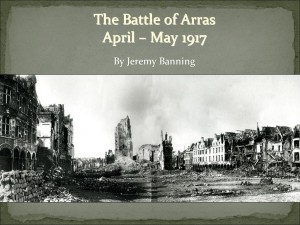 It was structured to not merely cover the battle but start with warfare in the Arras area in October 1914, look at the costly French actions of 1915 and then move on to British occupation in March 1916. The German attack against the 47th (London) Division on Vimy Ridge was touched upon and then I covered a basic backdrop to battle from the political and military standpoint and explained in detail the new German policy of ‘elastic defence’ to be brought into play for 1917. Moving through the Chantilly and Calais conferences I then spent some time on the German retreat to the Hindenburg Line (Operation Alberich) before exploring preparations for battle such as the tremendous work of the Royal Engineers. I also looked into French preparations, the actions of General Robert Nivelle and the extraordinary series of leaks and security lapses that marred the French pre-battle period. By this time half an hour had gone but I felt it important to set the scene fully and not merely delve straight into the battle itself.
It was structured to not merely cover the battle but start with warfare in the Arras area in October 1914, look at the costly French actions of 1915 and then move on to British occupation in March 1916. The German attack against the 47th (London) Division on Vimy Ridge was touched upon and then I covered a basic backdrop to battle from the political and military standpoint and explained in detail the new German policy of ‘elastic defence’ to be brought into play for 1917. Moving through the Chantilly and Calais conferences I then spent some time on the German retreat to the Hindenburg Line (Operation Alberich) before exploring preparations for battle such as the tremendous work of the Royal Engineers. I also looked into French preparations, the actions of General Robert Nivelle and the extraordinary series of leaks and security lapses that marred the French pre-battle period. By this time half an hour had gone but I felt it important to set the scene fully and not merely delve straight into the battle itself.
I structured the actual battle part of the talk by focussing on the First and Third Army fronts from north to south, starting with the Canadian Corps attack on Vimy Ridge before moving into what I always think of the main ‘Arras proper’ battlefield. Realising that no talk about the Battle of the Somme would neglect to work its way down the front line for 1 July 1916 I adopted the same structure – following each division’s success (or failure) as we moved southwards across the Scarpe and Arras-Cambrai road into Hindenburg Line territory until ending with the 21st Division at the south of the attacking frontage. Explaining the reasons for success in many sectors and failure in others I then worked my way through the battle focussing on stand-out actions. These included the capture of Monchy-le-Preux on 11 April 1917 and the destruction of the cavalry of the Essex Yeomanry and 10th Hussars in the village.
I also covered the attack by two battalions of the 10th Brigade (4th Division) towards the village of Roeux and the Chemical Works. 1/Royal Irish Fusiliers and 2/Seaforth Highlanders suffered grievous losses in the attack; the Seaforths attacked with 12 officers & 420 Other Ranks and their losses were all 12 officers & 363 O.R. This meant that a mere 57 men survived the action unwounded – and the objective wasn’t gained in any way. The beautiful Seaforths Cross on the Sunken Lane at Fampoux is a reminder of the men who attacked and suffered so much that day. I touched on the fighting at Bullecourt that day but felt that the disastrous actions around that particular salient village warranted a talk of their own.
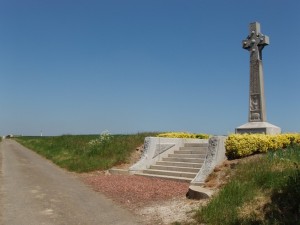 The next attack to be looked into was the attack up Infantry Hill by the Newfoundland Regiment and 1/Essex Regiment on 14 April 1917 – an attack that almost destroyed both battalions and which left the way open for the German reoccupation of Monchy. The day was saved by a gallant band of men led by Lt Col James Forbes Robertson, CO of the Newfoundlanders who organised a small group of men to run to eastern buy discount ambien edge of village and open rifle fire. For five hours their fire held the Germans at bay until the village was relieved. All were decorated and became known as ‘The Men Who Saved Monchy’.
The next attack to be looked into was the attack up Infantry Hill by the Newfoundland Regiment and 1/Essex Regiment on 14 April 1917 – an attack that almost destroyed both battalions and which left the way open for the German reoccupation of Monchy. The day was saved by a gallant band of men led by Lt Col James Forbes Robertson, CO of the Newfoundlanders who organised a small group of men to run to eastern buy discount ambien edge of village and open rifle fire. For five hours their fire held the Germans at bay until the village was relieved. All were decorated and became known as ‘The Men Who Saved Monchy’.
I then worked through the month of April, looking at the failed French attacks on the Aisne and then explaining the movements of 23 April (Second Battle of the Scarpe) with particular emphasis on the fighting for Roeux and the Chemical Works by the 51st (Highland) Division. The battle was deteriorating against well organised and deployed German troops employing the new ‘elastic defence’ doctrine. It was a dreadful time – Third Army suffered 8,000 casualties alone on the 23rd/24th April.
It seemed apt giving the talk on 28 April as I then touched on the attack that day 94 years ago and the capture of the village of Arleux. It was building to the climax of battle – the Third Battle of the Scarpe on 3 May 1917 – a very dark day indeed for the British Army. The 21km frontage from Fresnoy in the north to Bullecourt (again) in the south lent itself to particular problems. The Australians at Bullecourt wanted a night attack to aid their chances of success – in the north this would have been disastrous for the attack on Oppy Wood. A miserable compromise was reached and Zero Hour was set for 3.45am – the attack was still to go in at night time. It was a terrible fiasco – many units were unable to even find their starting points and had no idea of direction to attack, merely following the direction of the artillery barrage with the hope of finding some Germans. Accounts mention morale being poor and a general malaise amongst the depleted attacking divisions. I read from the Official History: Military Operations France and Belgium 1917 by Cyril Falls as it summed up most eloquently the reasons for failure on 3 May 1917:
“The confusion caused by the darkness; the speed with which the German artillery opened fire; the manner in which it concentrated upon the British infantry, almost neglecting the artillery; the intensity of its fire, the heaviest that many an experienced soldier had ever witnessed, seemingly unchecked by British counter-battery fire and lasting almost without slackening for fifteen hours; the readiness with which the German infantry yielded to the first assault and the energy of its counter-attack; and, it must be added, the bewilderment of the British infantry on finding itself in the open and its inability to withstand any resolute counter-attack.”
I concluded with the finals stages of battle, the loss of Fresnoy and eventual capture of Roeux and the Chemical Works and for my last slide whilst talking about the men who had done the fighting I showed one of my favourite pictures. It shows a triumphant shot of a group of the 12/West Yorkshire Regiment in Arras celebrating their success of 9 April with captured booty. I was amazed when a man in the front put his hand up, saying he had spotted his grandfather in the photo! Apparently the only wartime souvenirs that his grandfather left were his medals and a copy of this photo. The man was 50496 Acting Corporal John Davison Johnson (marked with a red arrow in the photo) and I thank his grandson, John Johnson for this information – it quite made my night!
All feedback received has been good and the Branch Chairman, Bridgeen Fox, wrote very warmly afterwards with her thanks. Her comments can be read here. As she herself said, “it should have raised the profile of the battles of Arras and I hope it will have encouraged more people to explore the area”.
When I have some time I will write a blog piece with detail about the 3 May fighting. My thanks to Geoff Sullivan from the wonderful ‘Geoff’s Search Engine’ for furnishing me with some tremendous statistics for that day. If anyone is intersted in hearing this talk then please contact me. I am speaking on this subject in Bristol in October – see here for details. For those with an interest in the battle our panorama book on the subject is available here. Alternatively, if you are interested in a battlefield tour to Arras then please contact me – I would be happy to discuss.
I was contacted by the Canadian Portrait Academy (CPA) when I first wrote a blog entry on the positive identification of Thomas Lawless. I initially saw news of this via my Twitter feed and realised what a good news story it was. I like to keep tabs on ‘news from the front’ and knew that this story fitted the bill perfectly. Little did I know the interest it would generate. Since that first post I have been heartened by the enthusiasm and generosity of those involved in the process to share their time and material so willingly.
The CPA have been wonderful in keeping me up to date with events and, through them, I have made contact with Christian Corbet, the sculptor who worked as the Forensic Artist with the Department of National Defence and others to reconstruct a likeness of Thomas Lawless.
Mr Corbet has kindly agreed to let me post images of his work on the facial reconstruction process. These photos are copyright and reproduced by kind permission of Christian Corbet. They show a few of the stages in the reconstruction process and are clear evidence of the levels of technical quality employed.
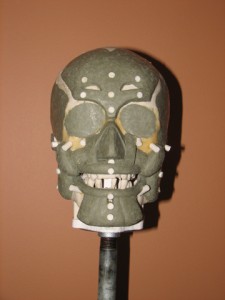
Facial reconstruction of Thomas Lawless 4 - muscles are placed on the skull, Copyright by Permission of Christian Corbet
The facial reconstruction procedure was the initial stage in the identification process and the end result (the sculpture) was used by Dr Andrew Nelson of the University of Western Ontario for computer superimpositions in order to identify the subject. Dr Nelson began his work on this particular identification process in 2007. The condition of the remains meant that Dr Nelson reconstructed the bony part of the midface in epoxy resin and a computer model of the skull was then made. A three dimensional print using bone fragments and photographic superimposition (for the midface) was then created.
This gave Christian Corbet the base to work from for a forensic reconstruction of the face (as shown in the photographs). The team had photos of all the proposed subjects and so a comparison could be made between the sculpture and photos. By eliminating those whose facial characteristics did not match, the shortlist was reduced to two soldiers – one from Cape Breton and the other from Ireland. It was at this stage that that Dr. Nelson suggested isotope analysis – the method by which the Irishman, Thomas Lawless was eventually identified. As Christian Corbet wrote to me, this multidisciplinary collaborative project is said to be a first of its kind in identifying a soldier of the Great War. I think that it is the model for future studies and shows what can be done with available resources, time and skilled personnel.
Mr Corbet’s protégé Benjamin Trickett Mercer told me that the 3-dimensional sculpture of Thomas Lawless took approximately 5 days to complete. It is estimated that approximately 25 – 30 hours were spent on finishing the formal portrait. Help regarding the accoutrements of a Great War soldier were provided by the costume department of the Canadian War Museum. This ensured that the correct regimental badges could be sculpted. They even assisted in the providing the essential but easily overlooked measurements for the size of the soft cap.
Burial – 15 March 2011
Mr Corbet and Benjamin Trickett Mercer attended the burial service on 15 March 2011. Mr Corbet had the honour to place flowers on the grave of Thomas Lawless on behalf of the Province of Newfoundland and Labrador.
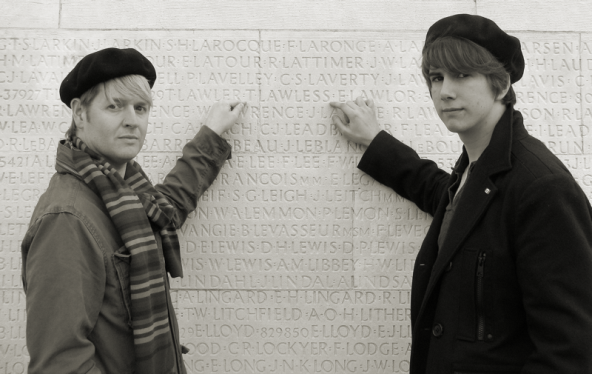
Christian Corbet and his protégé Benjamin Trickett Mercer pointing to the name of Thomas Lawless at the Vimy Memorial. Copyright by Permission of Christian Corbet
On the same note, I received a Press Release earlier from the CPA. It is shown below in italics along with the photograph.
Newfoundland and Labrador Presents Floral Tribute to Fallen WWI Soldier
Avion, France – In an act of respect the province of Newfoundland and Labrador paid homage with a floral bouquet at the burial of Pte. Thomas Lawless on 15th March in Avion, France.
Premier Dunderdale granted permission to Christian Corbet an Academician of the Canadian Portrait Academy to lay flowers of white lilies and red roses upon the grave of Pte. Lawless. Pte. Lawless’ fought at the Battle of Vimy Ridge and his identity was recently released after he went missing in action in June 1917.
This floral tribute was the only one presented from a province or territory from Canada.
Christian Corbet who worked as the Forensic Artist with the Department of National Defence among other institutions in order help identify the remains of the World War I soldier stated “This bouquet of flowers was Newfoundland and Labradors way of saying “Thank You for laying your life down for the freedom we so often take for grated today.” The Irish descendants of Pte. Thomas Lawless were greatly appreciative and grateful for such a kind gesture.”

Christian Corbet presented a floral tribute to fallen WWI soldier on behalf of the Province of Newfoundland and Labrador at La Chaudiere Military Cemetery, France. Photo Credit: Benjamin Trickett Mercer, CPA.
For more information on the burial: http://www.cmp-cpm.forces.gc.ca/dhh-dhp/adh-sdh/news-nouvelle-eng.asp
Please find below some more photos of the burial service, courtesy of Christian Corbet.
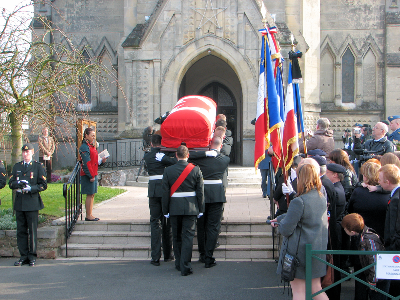
The coffin of Thomas Lawless is carried into the church of Saint-Martin de Vimy. Copyright by Permission of Christian Corbet

Canadian armed forces and standard bearers at the funeral service of Thomas Lawless. Copyright by Permission of Christian Corbet

Thomas Lawless's coffin is carried to his grave at La Chaudiere Military Cemetery, Vimy. Copyright by Permission of Christian Corbet
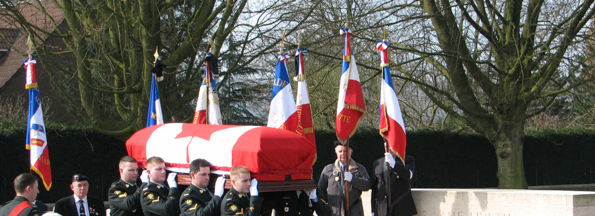
Thomas Lawless's coffin is carried past French standard bearers. Copyright by Permission of Christian Corbet
I would welcome any comments you have on the subject.
Today saw the burial of Private Thomas purchase tramadol generic ultram Lawless, 49th Battalion, Canadian Expeditionary Force almost 94 years after he was killed in action. He was buried with full military honours at La Chaudière Military Cemetery in Vimy with members of his family in attendance.

Burial of Private Thomas Lawless, 49th Battalion, CEF at La Chaudière Military Cemetery, Vimy on 15 March 2011
The remains of Private Lawless and Private Herbert Peterson were found by construction workers near Avion in 2003. They had been killed in August 1917. Subsequent forensic procedures identified Peterson in 2007. The positive identification of Lawless was announced last month – see my blog post: Remains of Canadian Great War soldier finally identified – Private Thomas Lawless, 49th Battalion CEF.
Some pictures of today’s ceremony from the Calgary Sun website can be viewed by clicking on: WWI soldier buried in France.
The pictures on this blog post were taken by a friend who attended today’s burial service. I was unable to make it to Vimy and so offer my thanks to Isabelle Pilarowksi for permission to use her photographs.
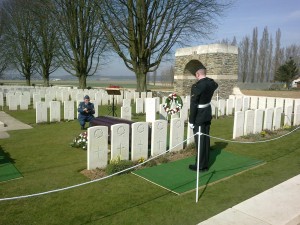
Burial of Private Thomas Lawless, 49th Battalion, CEF at La Chaudière Military Cemetery, Vimy on 15 March 2011
I will be posting some pictures soon from Christian Corbet, the renowned Canadian sculptor of his work on the facial forensic reconstruction of Lawless’s face. Mr Corbet has been kind enough to supply these for my site. Please see this post for the pictures.
The Department of National Defence announced the news of today’s burial here. A full transcript of that announcement can be found below in italics.
PAS-DE-CALAIS, France – Nearly a century after his death, Private Thomas Lawless, a Canadian First World War soldier whose remains were recovered and identified on January 10, 2011, was buried today with full military honours at La Chaudière Military Cemetery, in Vimy, France.
“The courage and dedication of our Canadian First World War heroes will never be forgotten,” said the Honourable Peter MacKay, Minister of National Defence. “After all these years, we finally recognize Private Thomas Lawless with the honour and dignity he so greatly deserves.”
Private Lawless was born on April 11, 1889, in Dublin, Ireland, and enlisted with the Canadian Expeditionary Force (CEF) in Calgary, Alberta. He was a member of the 49th Battalion, CEF, who fought in the Battle of Vimy Ridge.
Veterans Affairs Canada has provided support to the family members of Private Lawless and has also coordinated their participation in the interment ceremony.
“It is very gratifying that we can properly lay to rest a Canadian who made the ultimate sacrifice for our country and our way of life,” said Honourable Jean-Pierre Blackburn, Minister of Veterans Affairs and Minister of State (Agriculture). “We are now able to share Private Lawless’s full story of courage with other Canadians and assure his family that we will remember him.”
In October 2003, two sets of human remains were found at a construction site in the vicinity of Vimy Ridge, France. The first soldier was identified in February 2007, as Private Herbert Peterson of Berry Creek, Alberta. On January 10, 2011, Private Lawless’ remains were identified by the Casualty Identification section of the Directorate of History and Heritage after a combination of anthropological, historical and biological research such as generic testing, osteology, facial reconstruction and military historic records were conclusive.
Remains of Canadian Great War soldier finally identified – Private Thomas Lawless, 49th Battalion CEF
I was delighted to read that a Canadian casualty of the Great War whose remains were found by construction workers near Avion in 2003 have now been identified using DNA. The man, a 28-year-old Irish immigrant 183425 Private Thomas Lawless, 49th Battalion (Alberta Regiment), Canadian Expeditionary Force was killed in a raid on the German lines on 9 June 1917.
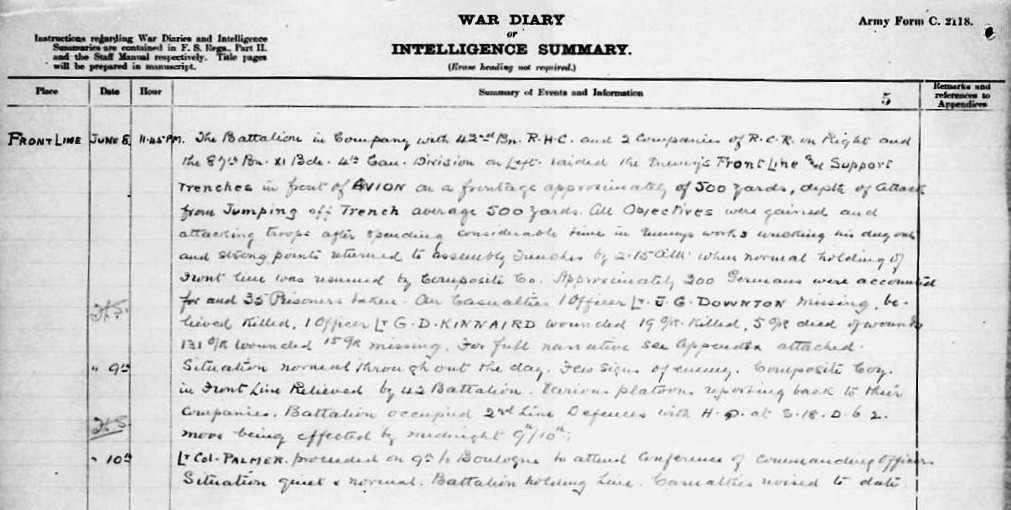
49th Bn War Diary extract 8th - 9th June 1917. Note the large losses - including 131 Other Ranks wounded and 15 O.R. missing. CLICK TO ENLARGE
Press reports indicate that his remains, along with those of 808723 Private Herbert Peterson of the same battalion, were discovered during a road-building project. Private Peterson’s remains were positively identified in 2007 and were buried with full military honours at La Chaudière Military Cemetery in Vimy in the same year.
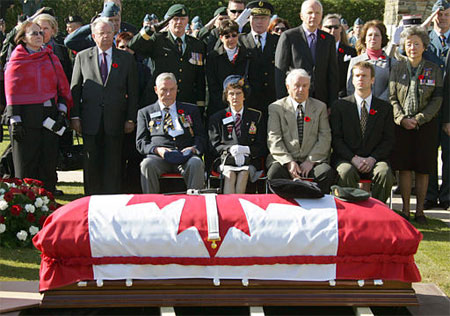
The burial of Private Herbert Peterson in 2007. He was killed on 9 June 1917 near Avion and his remains were found by construction workers in 2003. Image by Michael Springler taken from www.reallygoodfriend.com
It took six years of research and testing before forensic scientists and DNA specialists could positively identify Thomas Lawless. The remains of both men had been returned to Canada because metal insignia identified their battalion and nationality.
The story has been covered in the Canadian Press. Links below to the Edmonton Journal and The Vancouver Sun.
The Vancouver Sun – Researchers ID fallen soldier from First World War
Thomas Lawless’s details are recorded in the CWGC register HERE. Interestingly he is reported as being buried in La Chaudière Military Cemetery in Vimy, despite the service not taking place until 15 March 2011. The service will take place with members of his Irish family in attendance.
As a ‘missing’ Canadian soldier, Thomas Lawless is still commemorated on the Vimy Memorial. The memorial is inscribed with the names of over 11,000 Canadian soldiers who were posted as ‘missing, presumed dead’ in France. The Canadian Virtual War Memorial confirms that Thomas Lawless is on the Vimy Memorial: PRIVATE THOMAS LAWLESS
Below is the official notification of the positive identification of Private Lawless: Historic Casualty Identification
BG–11.002 – February 24, 2011
The Government of Canada, the Department of National Defence and the Canadian Forces are dedicated to honouring those who have made the ultimate sacrifice by ensuring that, when possible, they will be identified and buried in a known grave.
Nearly 28 000 members of Canada’s Army, Air Force, and Navy who died in the First and Second World Wars and the Korean War have no known or maintainable grave. The majority of these service personnel – approximately 19 500 – went missing in France and Belgium during the First World War. Every year, some of the formerly missing are discovered, and the Department of National Defence is responsible for using historical and scientific methods to determine their identity.
Identification is the result of a collection of historical research and biological tests which eventually determine the most likely serviceman.
The first step in identification is to search records, such as military personnel records, burial registrar records, war diaries and maps, and regimental histories to create an historical profile of the unknown person. Purely historical identifications are rare, however, and DND usually seeks biological evidence to support other documents.
Biological anthropologists study the remains to determine the number of persons, their ages and heights, their dental health, their overall health and if possible, clues as to how they may have died. The resulting profile can further reduce the final list of candidates, and genetic testing of the remaining candidates can lead to an identification or reduce the candidate pool further.
Genetic testing of war remains requires that DNA be extracted from bone or teeth and then compared with genetic material donated by the descendents of the candidates.
Unfortunately, the use of DNA, while a method which has made identification more likely, can be limited by the availability of donors and the difficulty of extracting viable DNA from older remains. More recently, National Defence has used stable isotope technology to help differentiate the origins of candidates. By using the regional properties of certain elements to track the mobility of an individual, stable isotope technology can detect the locations in which an individual has been raised (to the age of approximately 21) and the locations in which an individual lived in the final ten to fifteen years of their lives. Such testing allows DND to exclude candidates based on where they were raised or where they lived prior to enlistment.
No doubt new technologies and increased access to historical documents will further enhance the precision and ability to identify Canada’s unknown soldiers, sailors and airmen and airwomen.
I think this is a great job by the Canadians and shows what can be done with some dedication and by providing the necessary budget. My congratulations go the Canadian government but also to the unsung heroes – the many professionals whose collaborative efforts in freely offering their time made this historical identification possible. Now, owing to their efforts, Private Lawless can finally rest in peace in a named grave. It would be wonderful if a similar effort was found in providing positive ID to the bodies of fifteen men from the York and Lancaster Regiment who were found in the French village of Beaucamps-Ligny in November 2009.

